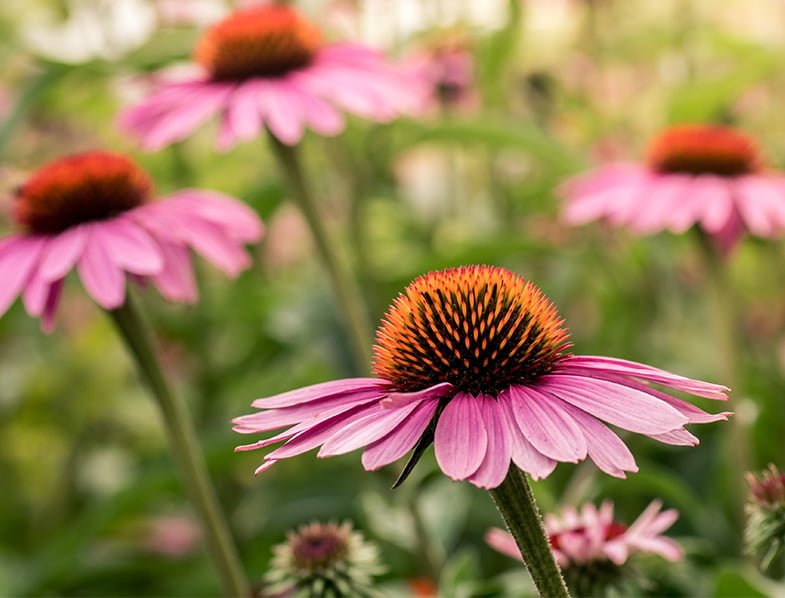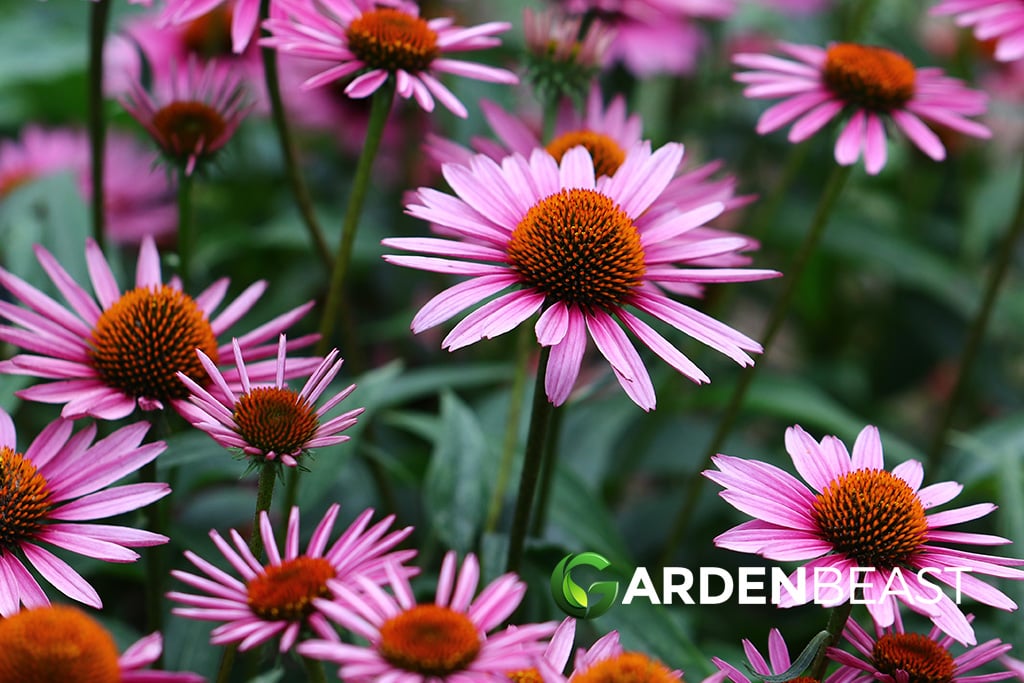Echinacea is a genus that contains exactly ten species of stunning herbaceous flowering plants. Commonly known in cultivation as Coneflowers, the species of this genus make for excellent garden ornamentals thanks to their showy flowers. They are versatile plants that can also fill any empty spot from your home as potted houseplants.
Echinacea plants look absolutely fantastic in naturalized areas, meadows, wildflower gardens, prairies, beds, and borders. Some gardeners plant them in mass because their flowers can provide a mesmerizing visual impact. These plants are a great addition to garden bouquets, lasting up to two weeks in a vase. After their petals have fallen, the cute cones can make for attractive ornamental pieces in dried flower arrangements.
Echinacea flowers are native to several areas of central and eastern North America where they grow mostly on prairies and open, wooded regions.
Although all Echinacea species have various medicinal properties, people use only three of them in herbal supplements − E. Angustifolia, E. pallida, and E. purpurea.
About Echinacea
- Echinacea plants belong to the large Asteraceae family. They share this family with many other well-known species including sunflowers, dandelions, daisies, chamomile, asters, and dahlias.
- Their genus name comes from the word “echinos”, which is the Greek for “hedgehog”. This name refers to their spiky feel and appearance of their flower heads.
- The most common varieties in cultivation are E. ‘Cheyenne Spirit’, E. ‘Flame Thrower’, E. ‘Mama Mia’, E. ‘Secret Affair’, E. ‘Sundown’, and E. pallida.
- In Western herbal medicine, people consider Echinacea plants one of the most effective detoxifiers for the circulatory, respiratory, and lymphatic systems. In Germany, for example, more than 200 pharmaceutical products contain Echinacea.
- Many traditional folks used E. purpurea as a treatment for various problems including burns, wounds, inflammation, insect bites and stings, snakebites, sores, fever, and cold.
- The roots of Echinacea plants are antiseptic, depurative, adaptogen, digestive, alterative, and also an aphrodisiac. Moreover, parts of these plants have a good stimulatory effect on the immune system.
- Echinacea plants are not poisonous to cats and dogs unless consumed in large quantities. You can safely grow them in your garden.
- They can make for companions to other interesting species of plants, such as Beard Tongue, Bee Balm, Butterfly Weed, Gentian, Globe Thistle, Goat’s Beard, Sea Holly, or Stonecrop.

Echinacea Features: An Overview
- They are herbaceous perennial plants that can reach from 2 to 5 feet (61-152 cm) in height and 1 to 2 feet (30-61 cm) in width. Echinacea plants have a long lifespan.
- Except for E. purpurea, which emerges from a short basal stem with fibrous roots, all species grow from taproots. The foliage of most Echinacea species consists of many leaves that grow alternately arranged on erect and unbranched stems.
- Their leaves are usually hairy and have a rough texture. While some species have elliptic to ovate-shaped leaves, others come with linear to lanceolate leaves.
- In general, Echinacea plants bloom in summer. During this season, they produce composite inflorescences that contain prominent, somehow cone-shaped blossoms.
- Their flowers have hypnotic, hemispheric to conic receptacles (paleae) that exhibit orange, red, or purple ends. They contain 8-21 petals that come in various shades of white, yellow, orange, red, pink, and purple.
- When their flower head opens, the blooms tend to point downward. All species are hermaphrodite, having both male and female parts.
- After their blooming period, in autumn, Echinacea fruits appear where the flowers once were. Each fruit (cypselae) presents tiny and dark seeds that can serve as propagation material.
Growing Echinacea
When you are among the happy owners of Echinacea plants, you will find out that they are usually very easy-going. The best thing about these flowers is that they can grow in absolutely any environmental condition once established. As long as you are paying attention to their early-stage basic demands, your journey together will be one of a kind!
In both outdoor and indoor settings, Echinacea plants grow at their best in bright and direct light. Make sure you plant your Echinacea babies in a location where they can receive at least six to eight hours of full sunlight daily. These flowers can also tolerate partial shade, but they will flop over with time and produce fewer blooms than usual.
Although Echinacea plants thrive in hot and dry climates, they can withstand a wide range of temperatures and humidity levels. However, these plants will not do so well in extremely humid environments or areas with frequent rainfalls.

In general, Echinacea plants have no problems when it comes to fungal diseases. As long as you provide them with good air circulation and well-draining soil, you will have no reason to worry about this issue. In case of white spots or mildew on their foliage, all you have to do is remove the infected parts right away.
Some pests like Japanese beetles, leafhoppers, and vine weevils can bother Echinacea plants once in a while. If you notice any suspect sign of infestation, remove the intruders with bare hands and apply a suitable insecticide/pesticide regularly.
Planting Echinacea
Want to give your Echinacea plants the time of their life? Well, experienced gardeners think that this is possible only when if manage to find the perfect growing medium for them. These flowers can remain in the same spot for a very long time, so it is very important to put a little extra effort into this part.
Echinacea plants show the best results when you plant them in a neutral to acidic and well-draining soil that is rich in organic matter. They can grow in almost any type of soil including clay, rocky, and sandy substrates. Before planting, make sure you mix a bit of compost with your soil to give these flowers a good start.
- Flowers - Purple Coneflower (Echinacea purpurea) produces a cone like center that displays purple colored petals facing downward. The plants will return yearly since they are a perennial flowering plant.
- Growth - Purple Coneflowers will grow to a mature height of about 24 to 36 inches tall and go great along driveways & in the back of a nice flower bed as well.
- Butterfly Garden - Coneflowers are among one of the best perennial flowers to include in a butterfly garden. They will attract all sorts of bees, butterflies and other pollinators to the garden.
- Quality - All seeds packaged by Seed Needs are intended for the current and the following growing seasons. All seeds are stored in a temperature controlled facility that is free of significant amounts of moisture.
- Quantity - Seed Needs offers generous quantities. You can share with friends and family, or you can save the extra seeds until the following season, if properly stored.
- 50 Mix Double Coneflower Seeds Echinacea Flower Seeds Perennial Garden
- Seeds of different colors to create a dream garden!
- High germination: tested 90 % of the germination rate.
- Suitable for beginners. Enjoy the whole process of seeds with friends or relatives.
- Growing well indoors and outdoor
Last update on 2024-01-30 / Affiliate links / Images from Amazon Product Advertising API
When Echinacea plants grow in suitable rich soils, they do not require any supplemental feedings. Too much fertilizer can cause these plants to become leggy with time. However, they will benefit from applications of compost once every year in spring. The compost will come along with a nice boost of nutrients, helping your plants to exhibit healthy foliage and flowers.
If you want to obtain an overall bushy appearance for your Echinacea plants, cutting them back in spring is the way of doing it. This process will ensure vigorous growth for your beauties and prolong their blooming season. You can also remove all the dead flowers from these plants to make room for new ones to emerge.
Watering Echinacea
Echinacea plants are drought-tolerant, but they will need some extra attention during their first year of life. Once your flowers have settled in, you can provide them with water only during the hot and dry summer months. If you are growing these plants indoors, look for pots with drainage holes at the bottom to avoid soggy conditions or waterlogging.
Although Echinacea flowers are tolerant of drought, they will actually perform better with little, but regular watering. Right after planting, water these plants daily for a week or so to help them settle in faster. In the rest of their first year of growth, they will do just fine with 1 inch (2.5 cm) of water weekly. Piece of cake!
Propagating Echinacea
If Echinacea plants have already stolen your heart, what could stop them from doing the same with your family members or friends? It is pretty impossible to resist their gorgeous flowers! After all, why not propagate these plants and surprise your beloved ones with a lovely gift? They respond well to division or seed-starting and (good news!) both methods are very beginner-friendly.
To propagate Echinacea plants through seeds, you must first equip yourself with garden gloves. The seeds are usually attached to sharp spines and will not hesitate to harm your skin while removing them from the cone. Once you have the seeds, they will require some cold stratification before sowing to germinate best.
If you want to start Echinacea seeds outdoors, either sow them directly in the ground in fall or milk jugs in winter. Indoors, you should simulate the cooler period by placing the sealed container filled with a damp seed-starting mix in the refrigerator for 8-10 weeks.
After this period, take the seeds out, plant them about 0.5 inches (1.3 cm) deep, then cover them with soil. With proper care, Echinacea seeds will germinate in 10-14 days. When the seedlings show up, place them under artificial lights until spring.
For faster results, you can propagate Echinacea plants through division. All you have to do is dig out the mother plants, divide their roots into 2-3 parts, then plant each divided baby into their permanent location.
In Conclusion
If a mix of nice-looking, low-maintenance, and herbalicious is what your garden lacks, Echinacea plants can be a great addition to your collection! Not only do these flowers have peculiar features, but they are also very easy to deal with in general. And with their wide range of diversity, you will have more than enough time to decide which one suits you best!



